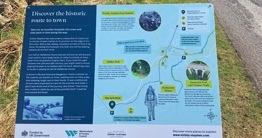Settle-Carlisle Railway
The Settle-Carlisle Railway is one of the most scenic railway journeys in England.
Travel through the Eden Valley and Yorkshire Dales. The 72 miles between Settle and Carlisle includes 14 tunnels and over 20 viaducts. It also includes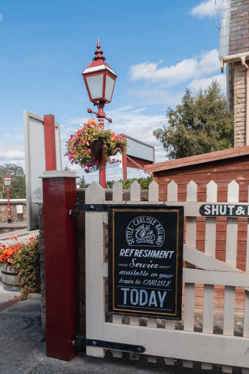 the famous Ribblehead Viaduct. Today, there are trains daily, run by Northern Railway. Look out for special steam excursions along the line as well.
the famous Ribblehead Viaduct. Today, there are trains daily, run by Northern Railway. Look out for special steam excursions along the line as well.
Visit their website for downloadable ‘Grand Days Out’ guides. These free guides contain a variety of short walks and suggestions of things to do and see at stations along the famous railway line.
The history of the Settle-Carlisle Railway
The history of the Settle-Carlisle Railway goes back to the 1860’s. Midland Railway has issues with sharing tracks with rival companies, carrying goods and passengers from London up to Scotland.
By 1865, the Midland had thought of the concept of the Settle-Carlisle and developed it. It applied to Parliament, and a Bill was passed to enable the line to be built.
The line is engineered to follow the natural pathways through the hills of the Pennines. It was also designed for high-speed running to compete for Anglo-Scottish passengers.
Construction began in 1869 and lasted for seven long years. Around 6,000 men worked on the line – the last main line railway in England constructed almost entirely by hand. Memorials along the line, especially that at Chapel-le-Dale, near Ribblehead, commemorate the lives of some of the men who died building the line. Many died through outbreaks of smallpox, as well as those injured or killed during construction. The line opened to passengers on the 1st of May 1876 and since then has stood the test of time. The Midland Railway became part of the London, Midland and Scottish Railway (LMS) in 1923. The small railway companies came together to form four large railway companies. These were in turn nationalised in 1948 to become British Railways, later British Rail.
In 1968, mainline steam ended in the UK and the service became entirely diesel-operated. Steam was not to stay away for long as charter trains were permitted again within a decade. However, all of the local stations except Settle and Appleby closed in 1970.
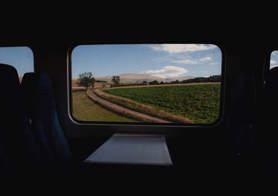 In 1981, it became apparent that there were proposals to close the line to passengers and to retain short sections to serve industrial sites. The key problem seemed to be the cost of repairing and waterproofing Ribblehead viaduct as it was then in a poor condition. BR suggested alternative bridges including a suspension bridge, however repairs were eventually made and the structure is entirely safe now. It is properly seen as the symbol of the line, and its resilience to closure. BR’s figures to support the closure proposal were at best misleading. This was due to trains being diverted away from the route to make the case for retaining the line worse. A new manager, Ron Cotton, was appointed as project manager for BR to close the line. He attracted many passengers to use the line. Local stations were reopened in 1986 following a series of walkers’ charter trains operated under the DalesRail banner since 1975. With considerable public protest and a huge rise in passenger numbers, in 1989 the Government declared that the line should stay open.
In 1981, it became apparent that there were proposals to close the line to passengers and to retain short sections to serve industrial sites. The key problem seemed to be the cost of repairing and waterproofing Ribblehead viaduct as it was then in a poor condition. BR suggested alternative bridges including a suspension bridge, however repairs were eventually made and the structure is entirely safe now. It is properly seen as the symbol of the line, and its resilience to closure. BR’s figures to support the closure proposal were at best misleading. This was due to trains being diverted away from the route to make the case for retaining the line worse. A new manager, Ron Cotton, was appointed as project manager for BR to close the line. He attracted many passengers to use the line. Local stations were reopened in 1986 following a series of walkers’ charter trains operated under the DalesRail banner since 1975. With considerable public protest and a huge rise in passenger numbers, in 1989 the Government declared that the line should stay open.
Since 1989, a considerable amount of work has been done along the line in upgrading stations and facilities. The highlight being Ribblehead station which had stood derelict for many years – it is now an award-winning visitor centre.
Stations in the Eden Valley
The Settle-Carlisle Railway connects the Eden Valley from Kirkby Stephen to Carlisle. Appleby station is the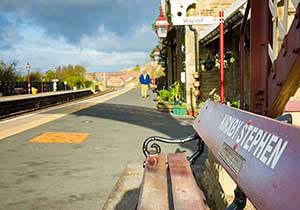 only manned station, where you can get tickets in person.
only manned station, where you can get tickets in person.
Each station has their own stories and histories and are still the traditional Midland style.
Kirkby Stephen Station
The station building is a wonderful example of Midland Railway architecture at its best. It was the only station on the line to have the luxury of a first-class waiting room. As with many of the station areas, many of the buildings you see in the immediate vicinity were constructed by the railway company.
The station is now leased by the Settle and Carlisle Railway Trust who have completely restored and refurbished it. It is now possible to stay in the station master's house.
Kirkby Stephen has plenty of shops, coffee shops and pubs. It sits nestled in the countryside about 1½ miles from the train station. A market is held on Mondays in the cobbled square. There are also toilet facilities in the town centre. The parish church known locally as the ‘Cathedral of the Dales’ was built on the site of an old Anglo - Saxon church. The church contains a Loki stone - one of only two such stones in the whole of Europe. Glorious countryside surrounds the town.
Visit the information centre in the town for details of the Northern Viaduct Trust Walks, the Poetry Path and route up to the enigmatic Nine Standards Rigg and Wild Boar Fell. From Pendragon Castle to the 17th Century Frank’s Bridge, Kirkby Stephen combines, history, great walks and natural beauty.
Appleby Station
The station is constructed using the ‘large’ type design and built with bricks. This was unusual for the Settle-Carlisle where most buildings have used stone. The platforms are the longest on the line at 200 yards, built originally for the purposes of the Anglo-Scottish expresses.
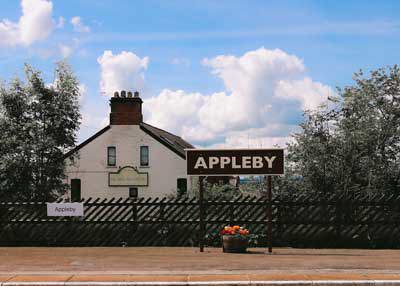 The station is set high above the town. There's a well-marked walk down to the town centre and River Eden. Allow time to walk back to the station as it is a steep climb uphill. There is a town plan by the exit from the northbound platform.
The station is set high above the town. There's a well-marked walk down to the town centre and River Eden. Allow time to walk back to the station as it is a steep climb uphill. There is a town plan by the exit from the northbound platform.
2011 saw a major refurbishment and improvement to the facilities at the station.
Appleby developed as the market town of Westmorland after the Norman conquest. A most famous resident was the remarkable Lady Anne Clifford. A formidable woman of her age, she devoted much of her time in the 1650s restoring the neglected estates surrounding the town and her home, Appleby Castle.
Appleby’s uncommonly wide main street, Boroughgate, has been described as one of the finest in England. At the north end are important cloisters. Walking up Boroughgate can transport you back into Medieval England. The charm of the riverside walks provides an opportunity to experience the tranquillity of the countryside within minutes of the town centre.
The Tourist Information Centre is on the ground floor of the Moot Hall, the ancient place where the Council still hold meetings.
Langwathby Station
Langwathby is an unmanned station having a waiting room on each platform.
Langwathby is a pretty rural village of pink stone cottages surrounding a large village green.
In May the local children still dance around a floral decorated maypole. This echos the traditional celebration of the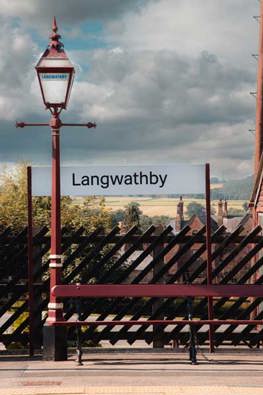 Goddess of flowers. The church takes its name from St Cuthbert. The Saint’s body rested at the church during a seven year journey. The body was taken by Anglican Monks, as they fled the Viking raids in Northumbria. Spanning several centuries, the church has a surviving Norman window, a Medieval font and a series of defensive machicolation type holes around the tower.
Goddess of flowers. The church takes its name from St Cuthbert. The Saint’s body rested at the church during a seven year journey. The body was taken by Anglican Monks, as they fled the Viking raids in Northumbria. Spanning several centuries, the church has a surviving Norman window, a Medieval font and a series of defensive machicolation type holes around the tower.
The River Eden flows close to the village. Floods in the 1960s washed away the old sandstone bridge to the south. The bridge was replaced by what is now the longest ‘temporary’ bridge in the county.
Lazonby and Kirkoswald Station
Built in the traditional Derby Gothic Style in the 1870s by George Black of Carlisle. The station included a Cattle Dock and a 12,000 gallon water tank.
In its heyday Lazonby was a busy station and handled a large volume of lumber from local forests. As well as livestock from the goods yard, which doubled as a centre for sheep auctions. The former goods yard and shed is now owned by a bakery, Bells of Lazonby, a major local employer.
Armathwaite Station
The original Armathwaite station building, now a private house, is a medium sized style station built from local red sandstone.
The waiting shelter on the Southbound side of the track is a good example of a stone waiting shelter in traditional Midland style.
Sitting on the edge of the River Eden, Armathwaite is a pretty village of pink sandstone cottages. It has many walks in the surrounding countryside. Just south of the village on the river’s edge, you can see five faces carved in the pink rock.
As well as exploring the village there are two signal boxes to see. One is at Armathwaite Station. Built in the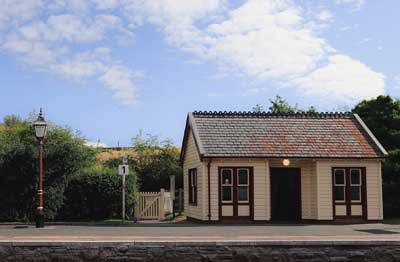 Midland Railway workshops and costing £260 in 1899 it closed in 1983. It has been leased to the Friends of the Settle Carlisle Line and restored to its original appearance. The signal box is open most Sundays and other times by prior arrangement.
Midland Railway workshops and costing £260 in 1899 it closed in 1983. It has been leased to the Friends of the Settle Carlisle Line and restored to its original appearance. The signal box is open most Sundays and other times by prior arrangement.
The second signal box is at Low House Crossing, just over 2 miles from the station. Built in 1900 as a type 2 design it controls one of only two level crossings on the line and can only be seen from the outside as it is a working box.
Carlisle Station
Carlisle is a mainline station serving several rail companies. The station is operated by Avanti West Coast.
The Citadel station was built in 1847 and was designed by William Tite, who was also responsible for the London Stock Exchange.
Carlisle has been in existence since Roman times. Sitting just south the Scottish Border, and located on the confluence of the rivers, Eden, Caldew and Petteril.
Early in its life Carlisle was a key support to Hadrian’s development of his famous wall cutting across the full width of the country a few miles to the north. In Medieval times Carlisle once again played an important military role situated as it is, so close to the border between Scotland and England. As well as a bustling shopping destination, the City also has a beautiful Cathedral, an impressive Castle and a fascinating Museum. You can also visit art galleries, have a game of golf, take in a show or visit a purpose built cycle circuit. There are some great green spaces too. Hammond’s Pond is situated on a hill just to the south of the centre of town. It has a picturesque lake, all weather sport surfaces, a cafe, playground and miniature railway.
Parking
Parking is available at all stations. Please check as charges may apply in Station car parks.
Group Travel
For groups of 10 and over, the friendly team in Appleby can help with organising a fully managed and supported group travel experience. They may be able to offer discounts on some trains for groups of 10 or more people.
For educational and youth groups with children under 16, year-round discounts are available.
More information
For more information visit the Settle to Carlisle Railway website.



